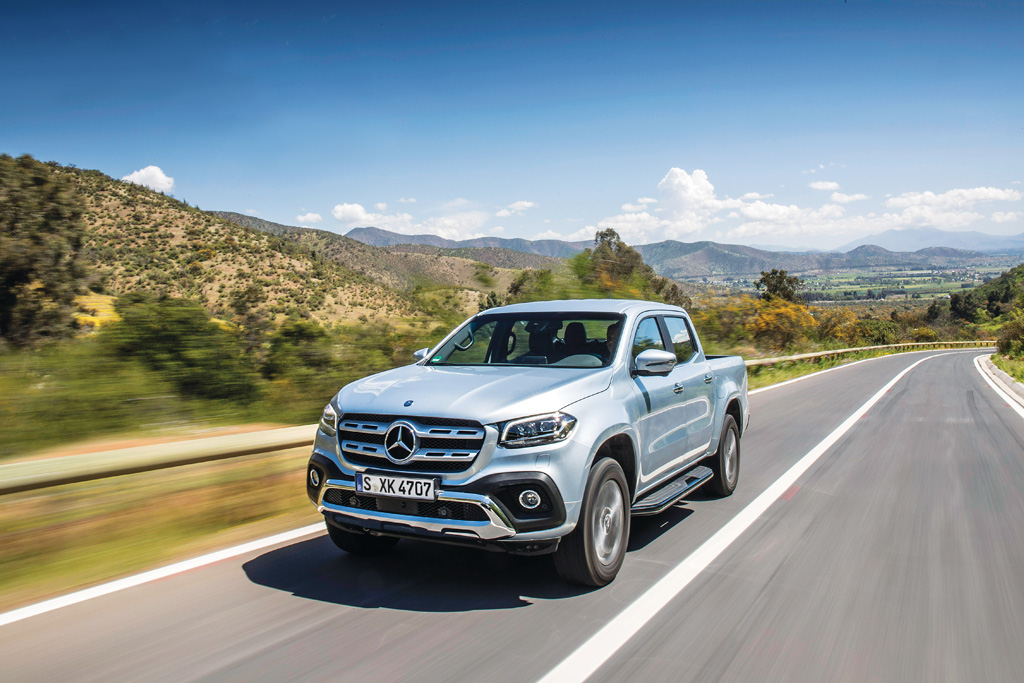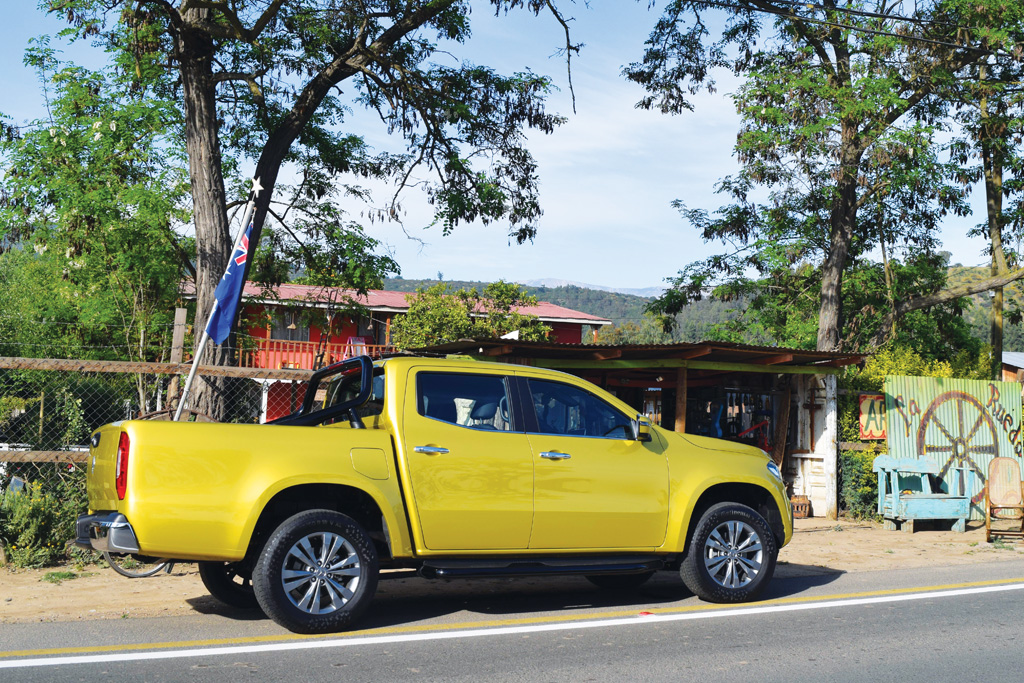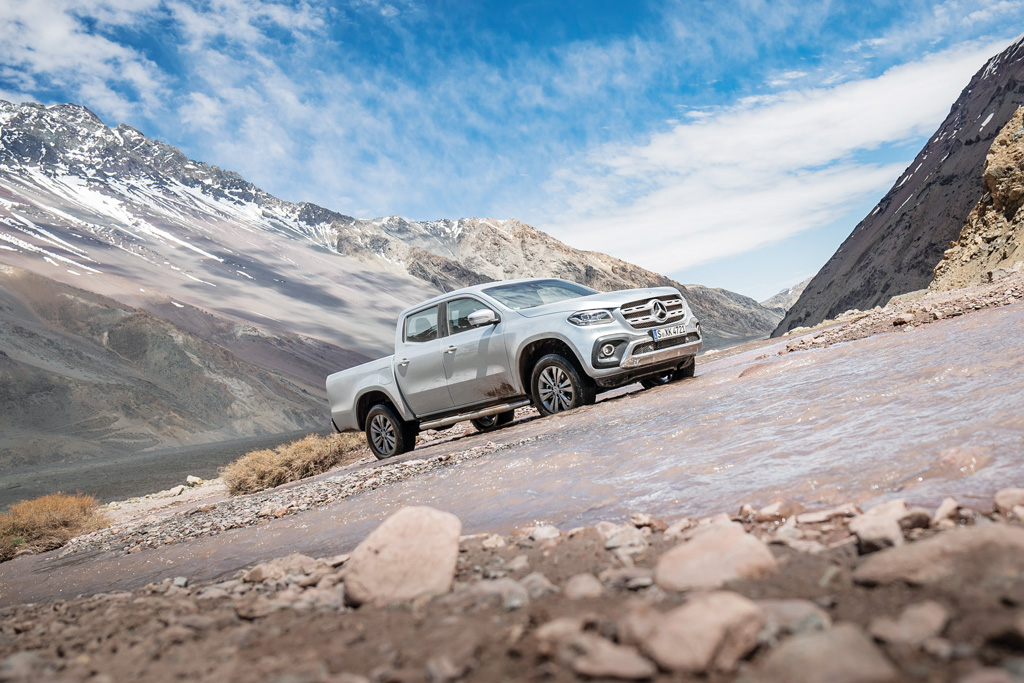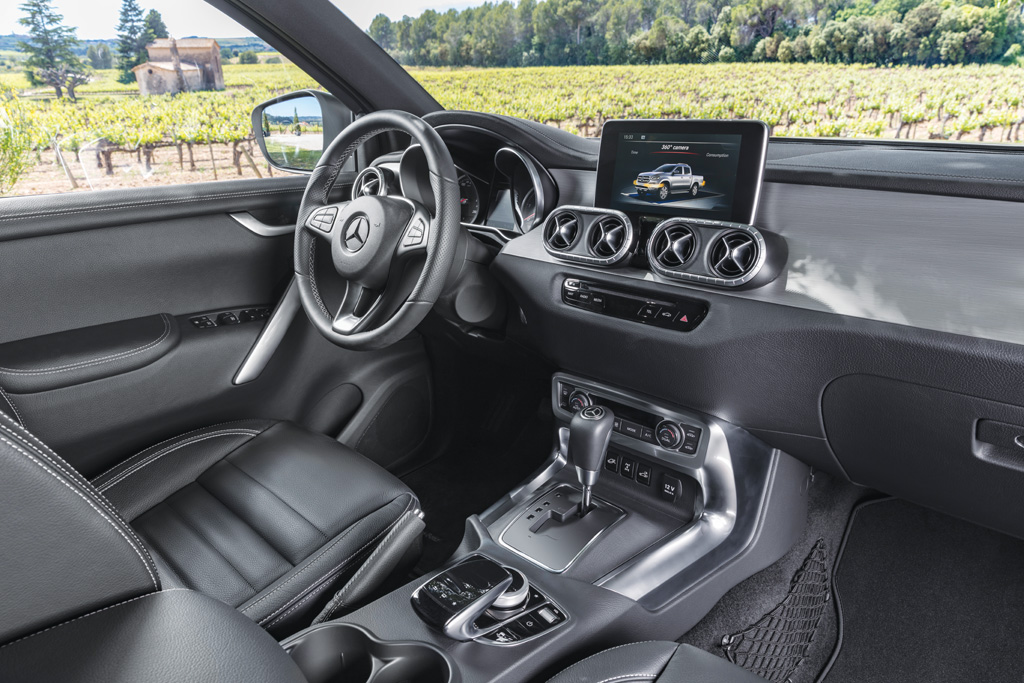Tale of typewriters and a terrific bakkie!

Did you know that Mercedes-Benz used to make a bakkie long, long ago? And that Mercedes (sans Benz) made a typewriter? CHARLEEN CLARKE travels to Chile to test drive the company’s latest pickup and encounters all sorts of surprises.
I’m standing next to the side of the road, conversing with the cutest little Chilean. He owns what some people would call a “junk shop”. My co-driver, on the other hand, would “platz” at this description. He calls these establishments “antique shops” – and his beautiful Hout Bay home is full of these rusty collectables (it’s even featured on Top Billing).
Irrespective of what you call the esteemed establishment, the shop in which we find ourselves is quite fascinating. Incredibly, given the fact that we’re in Chile to test drive the all-new Mercedes-Benz X-Class, we even discover a Mercedes typewriter!
We assume that Mercedes-Benz must have dabbled in the typewriter business at some stage. “Not so,” the cute Chilean informs us. “It wasn’t actually made by the automaker; rather it was made by a company called Mercedes Büromaschinen GmbH, which was established in Berlin on December 11, 1906.”
As it happens, Daimler wasn’t very happy with the company using the Mercedes name – and it litigated, but it was difficult to succeed in the litigation as Mercedes was a common first name at the time.
Eventually, in 1913, the two companies agreed to disagree, and, after paying 20 000 marks, the courts granted Mercedes Büromaschinen permission to continue using the name for typewriters, calculators and office equipment.
It wasn’t, however, allowed to use the name if it ever made anything related to transport. Daimler retained the use for its cars, but was forbidden to use the name on typewriters (lest it decided to expand into this field).

We bash away at the Mercedes typewriter, take silly photographs and debate the merits of taking the typewriter back home (I mention that it would be quite nice to take the little Chilean, too; he’s way cuter than a garden gnome). We have plenty of space for both in the back of our metallic yellow X 250 d 4Matic.
Actually, we have space for a small army of typewriters and little Chileans; the X-Class can haul a payload of up to 1,1 t. That’s enough to transport 17 full 50-litre barrels of beer in the cargo area!
Able to tow up to 3,5 t, the X-Class can pull a trailer containing three horses or an eight-metre yacht. I can see that my co-driver, who is in lust with anything old and rusty (maybe that’s why he likes driving with me), is tempted to buy the whole shop, but then sanity prevails – and we continue on our roads through the winelands of Chile, with an empty loadbox and sans trailer.
After an hour or so of driving, we arrive at a lovely little roadside café, where we stop for coffee. This gives us ample opportunity to admire the exterior of the bakkie. We agree that, while we’re not mad about the rear (it’s a little bland), we love the brash, bold front end – which screams “Mercedes”.
Back on the road again, precisely the same applies to the interior, we note. It’s decidedly Mercedes. In fact, if you zoomed in on the interior and ignored everything else about the vehicle, you could easily be forgiven for believing that you’re driving a C-Class.

There are three derivatives within the X-Class range: Pure, Progressive and Power. Pure is the most basic of the lot; it’s meant to be an entry-level model (actually there’s nothing entry level about it at all) and it’s designed to serve as a workhorse. The Progressive is one level up, with a plusher interior.
The top-of-the-range model, the Power, is what we’re driving – and boy oh boy is it plush. The interior features more leather than a herd of cows and we just love the seats, because they’re mighty comfortable (we’re driving many hundreds of kilometres all over Chile).
The Power has electrically adjustable seats and electric two-way lumbar support as standard – so it’s easy to find the perfect driving position. We’re also impressed by the 8,4-inch screen (the biggest display in its segment) that’s linked to the Comand online multimedia system, which has a resolution of 960×540 pixels and high-contrast In-Plane Switching technology. It offers a brilliant display that markedly increases the image quality of the very handy 360ᵒo camera and the navigation maps.
The next stop is lunch. (As any motoring or transport journalist will tell you, launches are as much about driving as they are about food.) Our test vehicle is fitted with a 2,3-litre biturbo motor, which generates 140 kW of power and 450 Nm of torque (a 2,3-litre turbocharged motor that develops 120 kW/403 Nm will also be available at launch).
Our X-Class has a seven-speed automatic transmission, but a six-speed manual box is also available. Our energetic and spritely motor gets us to the lunch spot – the magnificent Viña Vik Vineyard and Winery, in the Millahue Valley – in no time at all.
Before we start noshing, we’re amazed by a static vehicle display. Of course, it includes the X-Class, but – more unusually – we’re greeted by another Mercedes-Benz bakkie. Call me ignorant (trust me, I’ve been called much worse), but I thought that the X-Class was the first pickup from Mercedes-Benz. It’s not! On display at the winery is the 220D, a Mercedes bakkie that was made in Argentina from 1972 to 1976. It was based on the W115 platform. Available in both single and double cab, it was often called “La Pick-Up” by the locals.
La Pick-Up also has distinctly Mercedes-Benz styling, but that’s where the similarity between the 220D and the X-Class ends. La Pick-Up probably didn’t pass any fancy safety tests, for instance. The X-Class, on the other hand, which comes with an arsenal of safety features – Active Brake Assist, Lane Keeping Assist and Traffic Sign Assist, to name but a few – is as safe as it gets.
We aren’t able to drive La Pick-Up, but anyone who thinks it had a car-like ride is living in La La Land. The X-Class, on the other hand, is decidedly car-like; we cannot stop marvelling at its exemplary levels of comfort and ride quality.

In fact, we agree that the X-Class is the first pickup that truly offers an excellent on-road performance. Even the noise levels are surprisingly low; those German engineers excelled themselves when they took the Nissan Navara/Renault Alaskan (on which the X-Class is based) and set about improving it. I haven’t driven the Renault, but the Mercedes is streaks ahead of the Nissan in this department (which is as it should be; the German product is bound to cost much, much more).
The following day, we tackle the final element of the launch programme: we’re going off-road. I had a brief taste of the vehicle’s off-road capabilities earlier in the year in Cape Town (we were taken for a drive during the vehicle’s world premiere) so I know that the X-Class doesn’t cringe at the idea of going off-road.
Still, I wonder at the extent of its abilities when I see the course that has been laid out; it’s like a mini Dakar – with some hectic obstacles that seem more fitted to a butch Unimog than to the rather pretty X-Class.
My fears are totally unfounded; the X-Class sails through the course, without so much as a hitch – like so much else about this bakkie, it is surprisingly good. My co-driver comments that I’m a terrific off-road driver. This compliment is not really deserved; the X-Class makes it ever so easy.
With the launch done and dusted, I ponder about the fact that we have no clue what the X-Class will cost when it comes to South Africa in April next year. Let’s hope we’re in for yet another surprise!

They said it!
The Daimler top brass are understandably excited about the new X-Class; it does, after all, represent a leap into a whole new sector for the company.
“The segment for mid-size pickups is ripe for a premium vehicle. With the X-Class we will open up this segment to new customer groups, just as we redefined the off-road segment with the M-Class more than 20 years ago. Our pickup convinces as a workhorse, yet also as a family and lifestyle vehicle. In short, the X-Class is the Mercedes among pickups.”
– Dr Dieter Zetsche, chairman of the board of Daimler AG and head of Mercedes-Benz Cars
“With the X-Class we are closing a gap in the portfolio between passenger cars and commercial vehicles. Mercedes-Benz Vans is already very successful internationally in this respect with the Vito and the V-Class. With the pickup, too, we have various international markets in mind. Mercedes-Benz Vans is thus becoming even more international in orientation.”
– Wilfried Porth, member of the board of management of Daimler AG, human resources and director of labour relations,
Mercedes-Benz Vans
“The X-Class is the first genuine pickup with convincing passenger car characteristics. It’s robust, strong and with good off-road capability – just like a pickup should be. It’s also aesthetically pleasing, dynamic to drive, comfortable, safe, connected and individual – as you would expect from a Mercedes. As a result, the X-Class pushes the boundaries of the classic pickup and makes this vehicle segment attractive for private use, too. With three design and equipment lines and an extensive scope of further individualisation options, we offer the ideal vehicle for a range of different customer groups and their needs.”
– Volker Mornhinweg, head of Mercedes-Benz Vans
“Like no other pickup, the X-Class manages being both tough and stylish, and is thus hot and cool at the same time. With its puristic and yet extremely emotional design, the X-Class is following a radically new approach for pickups.”
– Gorden Wagener, head of design at Daimler AG
Published by
Charleen Clarke
One Comment
Leave a comment Cancel reply
focusmagsa





those trucks look amazing. Thanks for sharing!